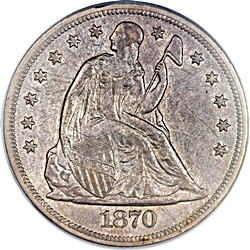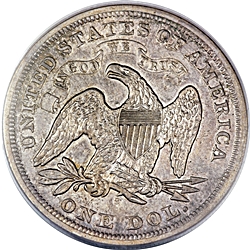 |
1870-S


|
 |
General Comments
|
| |||||||||||||||||||
The finest known example is a PCGS MS62 that currently resides in the Legend Collection, now owned by Dell Loy Hansen. The known examples are listed below (reference 19).
Position | Description |
| James A. Stack Specimen, PCGS MS62 | |
| Norweb Specimen, PCGS AU58 | |
| Eliasberg Specimen, PCGS AU53 | |
| Ostheimer-Gardner Specimen, PCGS XF40 | |
| Quellar Specimen, NGC XF40 | |
| Schultz Specimen, PCGS VF25 | |
| Carter Specimen, VF | |
| Eureka Specimen, F/VF scratched | |
| Boyd Specimen, PCGS VF, tooled to remove initials |
1870-S Die Marriages
A single die pair was used to strike all currently known 1870-S examples. The obverse die was one previously used in Carson City to strike 1870-CC die marriage OC-1. The mint had not provided obverse dies dated 1870 to San Francisco, so this obverse die was shipped from Carson City prior to the ceremony laying the symbolic cornerstone for the new San Francisco mint. The ceremony was held on May 25, 1870. The discovery this re-use of the 1870-CC obverse die was documented by the authors in an article in Issue #128 of the Gobrecht Journal, published in the spring of 2017 (reference 21).
The obverse die was polished prior to its use in San Francisco. Many of the die markers noted in our description of its use at Carson City were removed by the polishing. However, enough remained to make a positive identification. The findings that led to this conclusion were documented in our article in Issue #128 of the Gobrecht Journal, published in the spring of 2017 (reference 21). To our knowledge this is the only known example of a die being used at two different mints. The reverse die is unique to 1870-S. We have not found it in any other years. Some publications have speculated that the mintmark was engraved in the die. Our findings indicate that it was not only punched, but actually double-punched. This is discussed more in the next section.
Click the links below to view the details of the die marriage.
Die Marriage |
Rarity |
Obverse Die |
Reverse Die |
Estimated Survivors |
| OC-1 | R7- | 1870-CC 1 | A | 9-11 |
| Photo credits:
All 1870-S photos: 1870-S PCGS XF40, ex. Gene Gardner, from the Heritage archives. |
